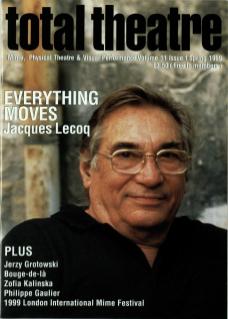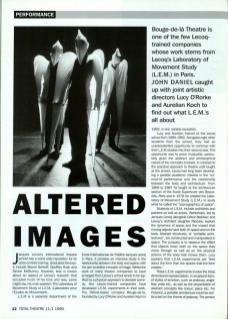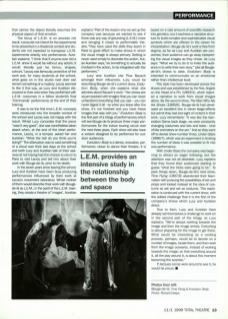Jacques Lecoq's international theatre school has a worldwide reputation for its actor-centred training. Graduates famously include Steven Berkoff, Geoffrey Rush and Simon McBurney. However, less is known about an aspect of Lecoq's research that occupied much of his time and was, some might say, his main passion: The Laboratory of Movement Study or L.E.M. (Laboratoire pour l'Etudes du Mouvement).
L.E.M is a separate department of the Ecole Internationale de Théâtre Jacques Lecoq in Paris. It provides an intensive study in the relationship between the body and space; with the aim to define a theatre of image. Whilst the work of many theatre companies to have emerged from Lecoq's school tends to be typified by a physical approach to devised comedy, few Lecoq-trained companies have developed L.E.M. experiments in their work. The Oxford-based company Bouge-de-là, founded by Lucy O'Rorke and Aurelian Koch in 1992, is one notable exception.
Lucy and Aurelian trained at the Lecoq school from 1990-1992. Alongside eight other students from the school, they had an unprecedented opportunity to continue with their L.E.M studies into their second year. This opportunity was to prove invaluable, particularly given the abstract and philosophical nature of the concepts involved. In contrast to the practical approach to theatre craft taught at the school, Lecoq had long been developing a parallel academic interest in the 'science’ of performance and the relationship between the body and architecture. From 1969 to 1987 he taught at the architecture section of the Ecole Superieure des Beaux Arts, Paris and in 1976 he created the Laboratory of Movement Study (L.E.M.) to study what he called the ‘scenographics of space’.
Students of L.E.M. include architects and painters as well as actors. Workshops, led by Jacques Lecoq alongside Grikor Belekian and Lecoq's architect daughter Pascale, explore the dynamics of space and the impact that moving objects have both on space and on the body. Abstract structures, or ‘portable architectures’, are constructed and manipulated in space. The purpose is to observe the effect that objects have; both on the space they move through as well as on the physical actions of the body that moves them. Lucy explains that L.E.M. experiments are ‘less about the form than the spaces that the form creates’.
These L.E.M. experiments involve the three-dimensional representation, in sculptural form, of states of emotion, such as jealousy, anger, fear, pride, etc, as well as the presentation of abstract concepts like colour, place, etc. For instance, a portable architecture could be constructed on the theme of jealousy. The person that carries the object literally assumes the physical aspect of that emotion.
The focus of L.E.M. is on process not result. Lecoq did not intend for the experiments to be presented in a theatrical context and students are not expected to transpose L.E.M. experiments directly into performance. Aurelian explains: ‘I think that if anyone ever did a L.E.M. show it would be without any actors; it would literally just be forms, shapes, colours.’ Lecoq was famously protective of the work and, for many students at the school, what goes on in the studio next door can remain something of a mystery. Lecoq seemed to like it this way, as Lucy and Aurelian discovered to their cost when they performed with L.E.M. costumes in a fellow student's final ‘Commande' performance at the end of their training.
It was to be the first time L.E.M. concepts were introduced into the broader context of the school and Lecoq was not happy with the result. Whilst Lucy concedes that the piece ‘wasn't very good’, she was nonetheless taken aback when, at the end of the short performance, Lecoq, in a temper, asked her and Aurelian: ‘What the hell do you think you're doing?’ The altercation was to cast something of a cloud over their last days at the school and both Lucy and Aurelian talk of their sadness at not having had the chance to return to Paris to visit Lecoq and tell him about their work with Bouge-de-là, prior to his death.
L.E.M. provides an intensive study in the relationship between the body and space.
In the seven years since leaving the school, Lucy and Aurelian have been busy producing performances influenced by their work at Lecoq's movement laboratory. Whilst neither of them would describe their work with Bouge-de-là as L.E.M., in the spirit of the L.E.M. training they create a ‘theatre of images'. Aurelian explains: ‘Part of the reason why we set up the company was because we wanted to see if there was any way of grounding [L.E.M.] more and bringing it closer to performable theatre.’ They have used the skills they learnt in Paris to good effect to make shows in which the visual image is always primary. Setting is never used simply to decorate the action, but, as Aurelian says, ‘as something to actually be involved in the action, to be integrated with the performers’.
Lucy and Aurelian cite Pina Bausch amongst their influences. Lucy could be describing Bouge-de-là's current show, Evolution: Body, when she explains what she admires about Bausch's work: ‘Her shows are so jam packed with imagery that you can never understand everything that you see, you can never digest it all – so when you leave after the show, it's not finished and you have these images that stay with you.’ Evolution: Body is the first part of a trilogy of performances which will see Bouge-de-là produce three major performances for the indoor touring circuit over the next three years. Each show will also have a version designed to be performed for outdoor audiences.
Evolution: Body is a dense, evocative performance; closer to dance than theatre. It is based on a vast amount of scientific research into genetics, but it eschews a narrative structure to build complex and sophisticated visual symbols which are offered to the viewer for interpretation. Bouge-de-là's work is free from dogma; as far as Lucy and Aurelian are concerned, their audience can go away interpreting the visual images as they choose. As Lucy says: ‘What we try to do is to invite the audience in to write their own story.’ Like all Bouge-de-là's shows to date, Evolution: Body is intended to communicate on an emotional rather than intellectual level.
This style has been developed across five shows and was established by the first, Angels on the Head of a Pin (1993/4), which rejected a narrative to work from visual images alone. By the second show, The Man Who Ate His Shoes (1995/6), Bouge-de-là had developed an excellent line in clever stage-effects but admit they had lost sight of content in their work. Lucy remembers: ‘It was like the Generation Game back stage, we were constantly changing costumes and bits and bobs - kind of like animators on the set.’ And so they went off to devise show number three, Under Glass (1996/7); which was an experiment in limiting the number of ideas it was possible to fit into one performance.
With Under Glass the company was beginning to attract an eager following, but the attention was not all desirable. Lucy explains that they found their audiences starting to ‘guess what the tricks were going to be’. To pare things down, Bouge-de-là's next show, Time Flying (1997/8) abandoned their fascination with pursuing the possibilities of set and props and looked instead at the idea of costume as set and set as costume. This exploration is continued with the current show, with the added challenge that it is the first of the company's shows which Lucy and Aurelian direct.
True to form, Lucy and Aurelian have already set themselves a challenge to work on in the second part of the trilogy, as Lucy explains: ‘We're always working towards the image and then the image arrives. Everything is about preparing for the image to get there. What would be interesting as a working process, perhaps, would be to decide on a number of images, locate them, and then work from the image outwards, instead of working towards the image: so that everything around it, all the play around it, is about this moment becoming the surprise.’
If Jacques Lecoq were around to see it, he would be proud.


